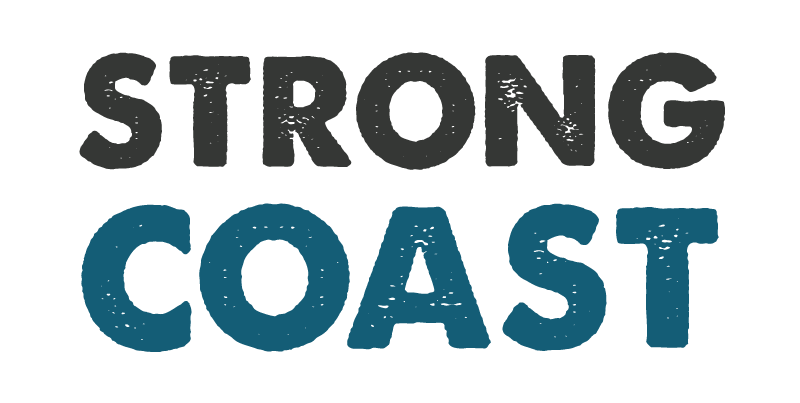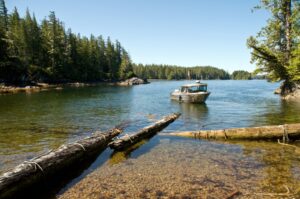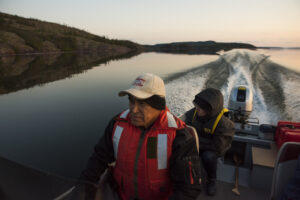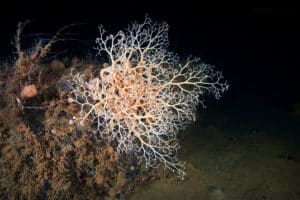
The Great Bear Sea Marine Protected Area (MPA) Network is a planned network of MPAs aimed at defending our coastal ecosystems and marine life, such as herring, prawns, crab, halibut, sablefish, rockfish, salmon, and other species of cultural and economic significance. The Network Action Plan for the Great Bear Sea defines a marine protected area (MPA) Network as “a collection of individual marine protected areas that operates cooperatively and synergistically, at various spatial scales, and with a range of protection levels, in order to fulfill ecological aims more effectively and comprehensively than individual sites could alone.” Coastal First Nations and the Canadian and British Columbia governments lead this initiative. It has involved extensive collaboration and stakeholder input, including commercial fisheries and coastal communities. The Great Bear Sea MPA Network seeks to protect the rich and productive ecosystem of the Great Bear Sea while supporting the resilience and economic strength of coastal communities. The Network aims to safeguard ecologically rich areas, which will assist in rebuilding fish stocks and building truly sustainable fisheries on our coast.
Where is the Great Bear Sea Marine Protected Area (MPA) Network?
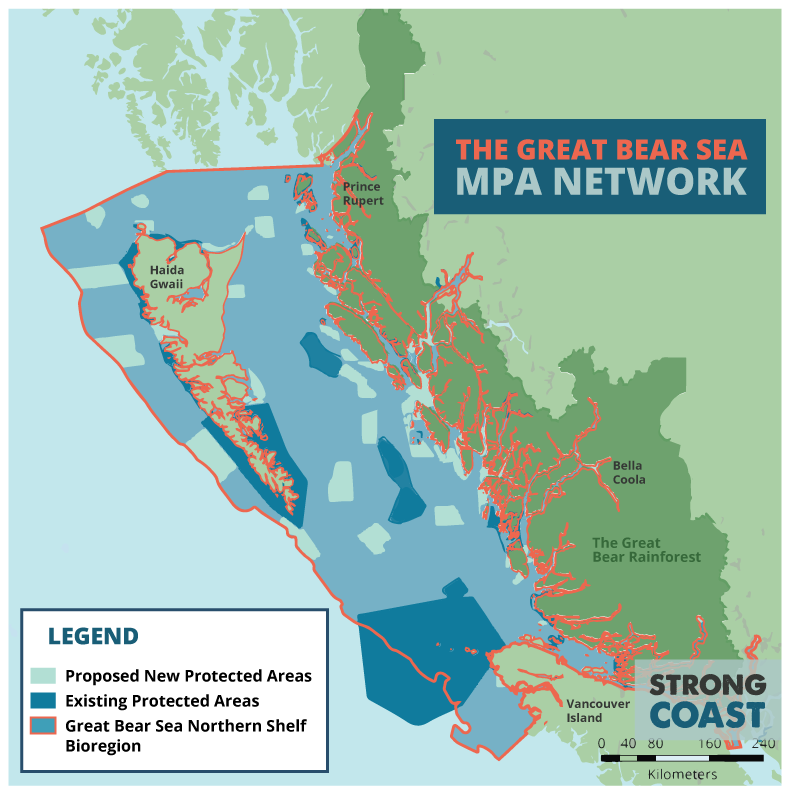
One common misunderstanding about the Great Bear Sea Marine Protected Area (MPA) Network is that it encompasses the entire Great Bear Sea. The ‘Great Bear Sea’ is often conflated with the ‘Great Bear Sea Marine Protected Area Network.” This conflation is problematic because it suggests that 100% of the Great Bear Sea will be a marine protected area (MPA). This mistake is often amplified by including a map showing the entire Great Bear Sea as a single MPA. The map above shows that the entire Great Bear Sea is not being turned into one huge MPA. Instead, it shows the Great Bear Sea running from northern Vancouver Island to the BC/Alaskan border. Within this Sea, there will be a network of marine protected areas (MPAs).
The map above shows that 30% of the Great Bear Sea will have various degrees of MPA protection. 18.5% of this 30% consists of existing marine protected areas and Rockfish Conservation Areas (RCAs), while 11.5% will be new MPAs. While some argue that 30% is not enough, it will increase the total percentage of protected waters in BC, as currently, only 3% is off-limits to industrial activity and large-scale commercial fishing, which is well below the United Nations Sustainable Development Goal 14 of protecting 10% of the world’s oceans by 2020. However, the Great Bear Sea Marine Protected Area (MPA) Network is a step in the right direction, and it will help Canada reach its international obligation of protecting 30% of its land and waters by 2030. Numerous studies have shown that the populations of many keystone species, such as salmon and herring, are dangerously low. When keystone species collapse, the entire Great Bear Sea moves closer to becoming a dead zone. The Great Bear Sea MPA Network can effectively defend against the unsustainable status quo and ensure a future where coastal communities thrive from sustainable fisheries.
The Maximum Sustainable Yield Approach Has Caused Fish Population Declines
On BC’s coast, the decline of the herring and salmon fisheries shows that the management systems used have not worked well. For example, the maximum sustainable yield approach to fisheries, which focuses only on single species, has proven unsustainable. This approach has put over 30 species on our coast at risk, including salmon, herring, northern abalone, northern resident and transient whales, blue whales, basking sharks, sei whales, yelloweye rockfish, and ancient glass sponge reefs. Maximum sustainable yield seeks to determine the maximum number of fish that can be harvested from a specific species, while still maintaining a sustainable population. However, this approach has been criticized for oversimplifying the complex interactions within marine ecosystems, such as predator-prey relationships, and for not adequately accounting for environmental variability. Critics argue that it can lead to overfishing if stock size or growth rates are overestimated. In fact, the maximum sustainable yield approach is responsible for the severe declines in herring populations on our coast, as year after year, the total allowable catch was too high. This was because, year after year, stock size was overestimated.

Danita Delimont
The maximin sustainable yield approach has been augmented with the precautionary principle. The precautionary principle identifies three stock status zones – healthy, cautious, and critical – with each status zone having a total allowable catch. The precautionary principle also improves maximum sustainable yield by adjusting the removal rate based on changing environmental factors. However, the precautionary approach is still based on fishing for the maximum sustainable yield, which means it is susceptible to miscalculations and the resultant overfishing. Continuing fishery management approaches based on maximum sustainable yield risks turning BC coastal waters into a dead zone. One way to reverse this trend and rebuild coastal abundance is establishing the Great Bear Sea Marine Protected Area (MPA) Network.
The Ecosystem-Based Approach is the Way Forward
The Great Bear Sea Marine Protected Area (MPA) Network will be managed using ecosystem-based management. This approach to marine management focuses on maintaining the health of entire ecosystems, rather than managing individual species in isolation. This method considers the cumulative impacts of various activities on marine environments and aims to ensure the sustainable use of marine resources. It balances ecological health, economic benefits, and social values by integrating science, traditional knowledge, and stakeholder input. Ecosystem-based management’s goal is to rebuild and maintain the health and wealth of our coastal communities by creating sustainable, thriving fisheries.
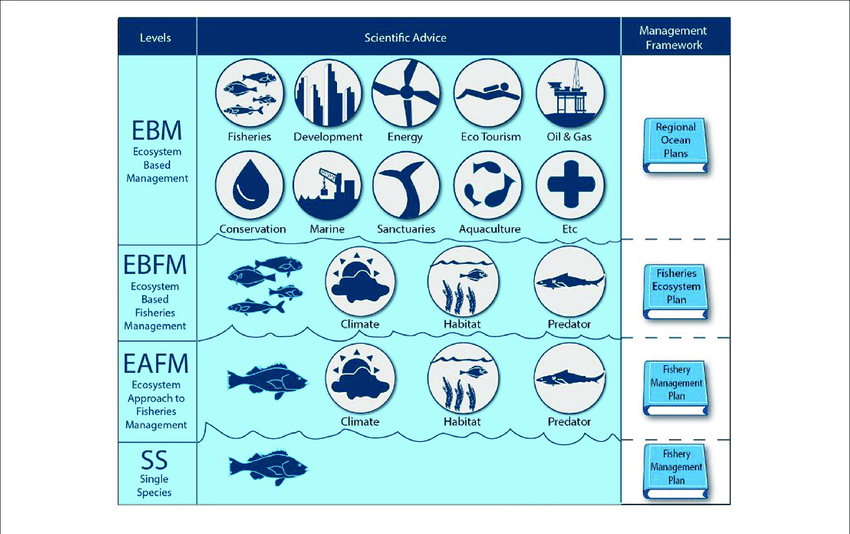
What are the Advantages of a Marine Protected Area (MPA) Network?
Well-managed marine protected area (MPA) networks protect ecosystem structure, function, integrity, and resilience in many ways. First, the Great Bear Sea Marine Protected Area (MPA) Network will provide refuge for harvested species by protecting areas necessary for their lifecycle. The Great Bear Sea MPA Network will protect habitats essential to lifecycle stages, including nurseries, spawning grounds, and feeding grounds. Protecting habitats critical to the lifecycle of various species allows these species to thrive across their lifespans, with the protection of spawning populations, biomass, and aggregations enhancing reproductive capacity, which will also ensure thriving populations. Numerous studies have found that within the boundaries of MPAs, fish biomass and numbers increase significantly. For instance, in an analysis of 87 MPAs, Edgar et al. found that the average increase in fish biomass was 670% higher inside well-managed marine protected areas than in similar unprotected areas. This increase in fish size and numbers in protected areas is the foundation of how the Great Bear Sea Marine Protected Area (MPA) Network will bring economic prosperity to the coastal communities of BC.
This potential economic prosperity is connected to the fact that the thriving fish populations created inside MPA-protected zones will not be strictly limited to these zones. Instead, the increased fish populations, including adults, juveniles, and larvae, will spill over into adjacent fishing grounds, which is the cornerstone of creating sustainable fisheries. Numerous studies have found significant increases in fishing grounds adjacent to marine protected areas (MPAs). For instance, a study published in Nature by Lenihan et al. found that the increased catch rate of resident species in fishing grounds adjacent to MPAs can be as high as 245%. Spillover is one of the main reasons a marine protected area (MPA) network can contribute to the long-term sustainability of marine resources on the BC coast. Studies such as Lenihan et al. provide evidence that the Great Bear Sea Marine Protected Area (MPA) Network will increase total allowable catch in fishing grounds on our coast. This counters the oppositional argument that MPAs will negatively impact fisheries. Studies indicate the exact opposite – marine protected areas (MPAs) will be a boon for fisheries and the coastal economy.
The Economic Benefits of The Great Bear Sea Marine Protected Area (MPA) Network
One of the most significant social and economic benefits of the Great Bear Sea Marine Protected Area (MPA) Network is that it will ensure a stable, diverse resource base for sustainable activities and livelihoods, including community fisheries, recreation, tourism, scientific studies, and marine management. Whereas the single-species approach has been disastrous for owner-operators and community fisheries, as it has privileged large corporations, the Great Bear Sea Marine Protected Area (MPA) Network endeavours to return fisheries and fisheries management back to coastal communities. This means the economic benefits attached to ecosystem-based management and spillover will flow to coastal communities instead of into the pockets of corporations like Canfisco and foreign fleets. The Great Bear Sea MPA Network will return fisheries to owner-operators and community fisheries.
The Network will also have several other advantages, including providing researchers, educators, and policymakers with reference sites to serve as natural benchmarks for fish biomass, management assessment, and climate change impacts. One of the foundational factors associated with the success of MPAs and MPA networks is local management, which takes decision-making power out of the hands of distant and disconnected federal bureaucrats and puts it back in the hands of coastal communities.
Who are the Coastal Guardian Watchmen?
One example of local control, which will be strengthened and amplified with the Great Bear Sea MPA Network, is Coastal Guardian Watchmen, a regional group affiliated with Coastal First Nations (CFN). Currently, the CFN nations with Coastal Guardian Watchmen programs are Metlakatla, Haida, Gitga’at, Kitasoo/Xai’Xis, Heiltsuk, Nuxalk, and Wuikinuxv. A significant development for the Coastal Guardian Watchmen came when the BC government gave Coastal Guardians from two Nations—Kitasoo/Xai’Xais and Nuxalk—the equivalent status of BC Park Rangers in 2023. This move, described as the first of its kind in Canada, signifies a formal recognition of the Indigenous Guardians’ traditional knowledge and their centuries-old role as caretakers of their lands. The Park Ranger status that these Watchmen now have gives them enhanced enforcement capabilities.
Coastal Guardian Watchmen play a critical role in all aspects of stewardship for Coastal First Nations on BC’s central coast, ensuring resources are sustainably managed, rules and regulations are followed, and land and marine use agreements are implemented effectively. Watchmen carry out their work using a combination of traditional Indigenous knowledge and contemporary management practices, including ecosystem-based management. Moving forward, Watchmen will be essential for effectively managing the Great Bear Sea Marine Protected Area (MPA) Network.

Conclusion
Significant evidence shows that the Great Bear Sea suffers from poor management, resulting in numerous species being classified as threatened or endangered. The continuation of the current approach to fisheries management does not bode well for the economies of coastal communities. However, there is still time to reverse the current trajectory. One way to defend our coast from corporate extractionists and the damage they are doing to the Great Bear Sea and coastal communities is the Great Bear Sea Marine Protected Area (MPA) Network and its ecosystem-based management.
